The Delaware chicken (originally Indian Rivers) is a 20th-century breed developed in the United States.
Delaware chickens are known for egg and meat production.
George Ellis developed the Delaware breed in the 1940s for meat production based upon its high maturity rate. However, its egg production was also desirable, so the breed became a dual-purpose one.
The Delaware chicken population has decreased over the years as more breeds emerge, making this a threatened breed.
Let’s learn more about the history, characteristics, and rearing practices of the Delaware chicken.
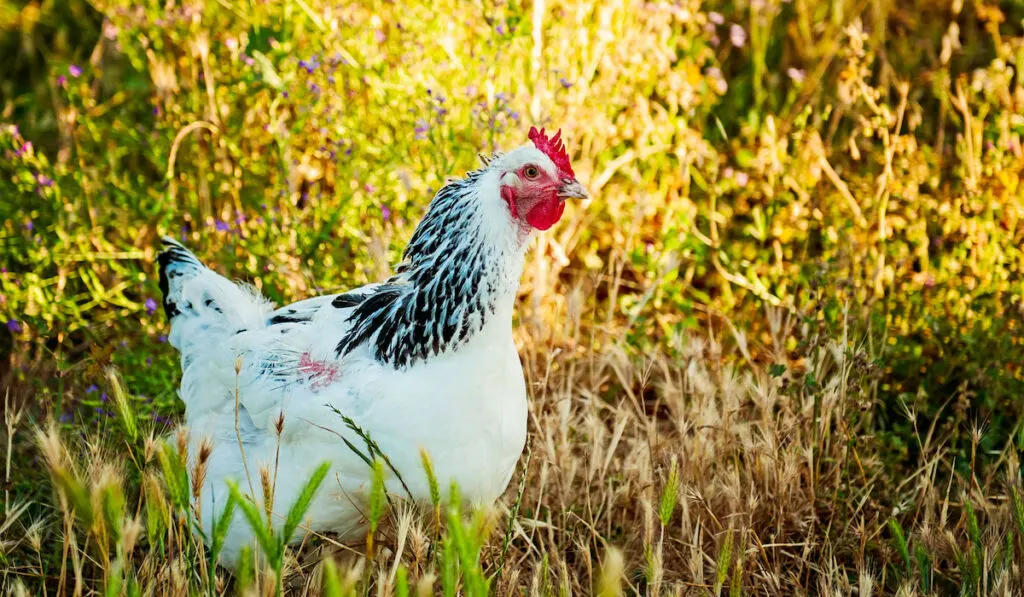
Table of Contents
History and Origin
The Delaware chicken is an American breed that first appeared in the 1940s.
George Ellis crossed the New Hampshire Red with the Plymouth Rock, and the Delaware emerged.
The breed’s name was initially Indian Rivers.
The name came from the hatchery where the parent breeds were crossbred. Later, the name changed to Delaware.
The desirable characteristics of this breed were to lay eggs and mature quickly for meat production.
Small-scale farmers in America reared this breed for its dual production.
Gardeners also favored the bird for its beauty and gentle temperament.
About 20 years after its production, many Americans switched to an alternative lifestyle. Many people migrated to urban areas and could not rear Delaware chickens.
In addition, the Cornish Cross (a better broiler) appeared and took over the broiler market. This impacted the Delaware negatively, causing its population to decline.
Thanks to the Livestock Conservancy, the breed was restored. Its population has grown in recent years as homeowners have started to rear it for its dual benefits and beauty.
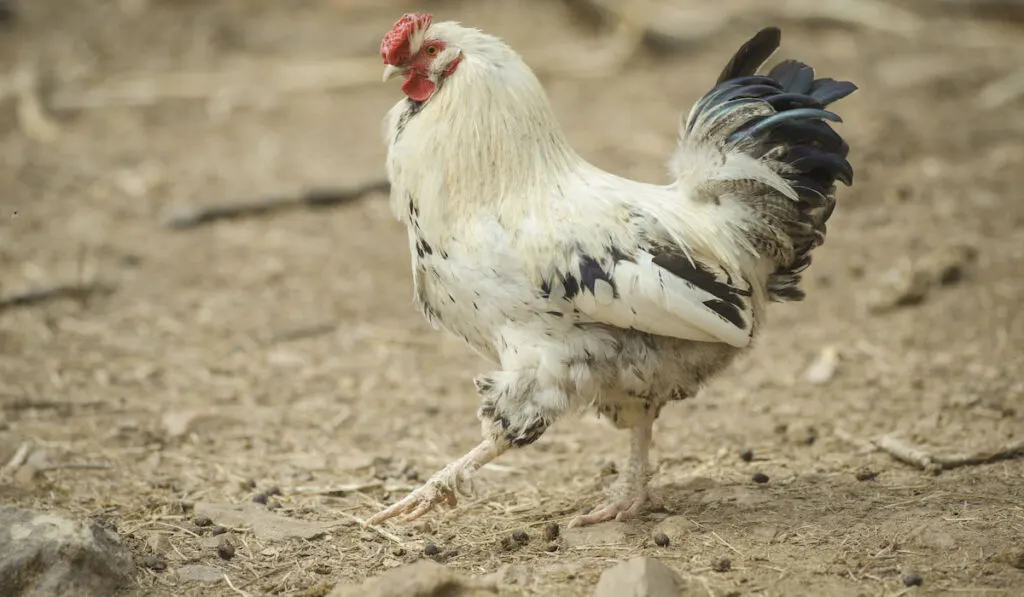
Characteristics
Size
A Delaware chicken grows fast and is medium weight. This favors its dual productivity.
Their bodies are deep and broad, with a triangular side view. Their long keel extends to the breast and behind the legs.
The muscular body and calm nature make the Delaware friendly and easy to handle.
A mature Delaware hen weighs about 6 lbs, while roosters weigh 7–8 lbs. Their bantam varieties weigh less.
A female Delaware bantam weighs 1.75 lbs, and a male weighs 2 lbs.
Color
Delaware chickens are all white except the tail and hackle, which have black specks.
The breed’s comb (with five points), wattles, and earlobes are all red, which contrasts with its yellow beak.
A mature Delaware has yellow-skinned legs with four toes on each leg. This breed’s colorful appearance adds to its aesthetic value.
Egg Laying
A Delaware hen will start laying when it’s 20–22 weeks old.
When healthy, one hen lays about 4–5 eggs per week.
Their eggs are light brown, although some may have light pink shades. Their shells are smooth and rounded.
The eggs are medium-sized, each weighing about 2 oz.
The egg yolk is yellow with a clear egg white.
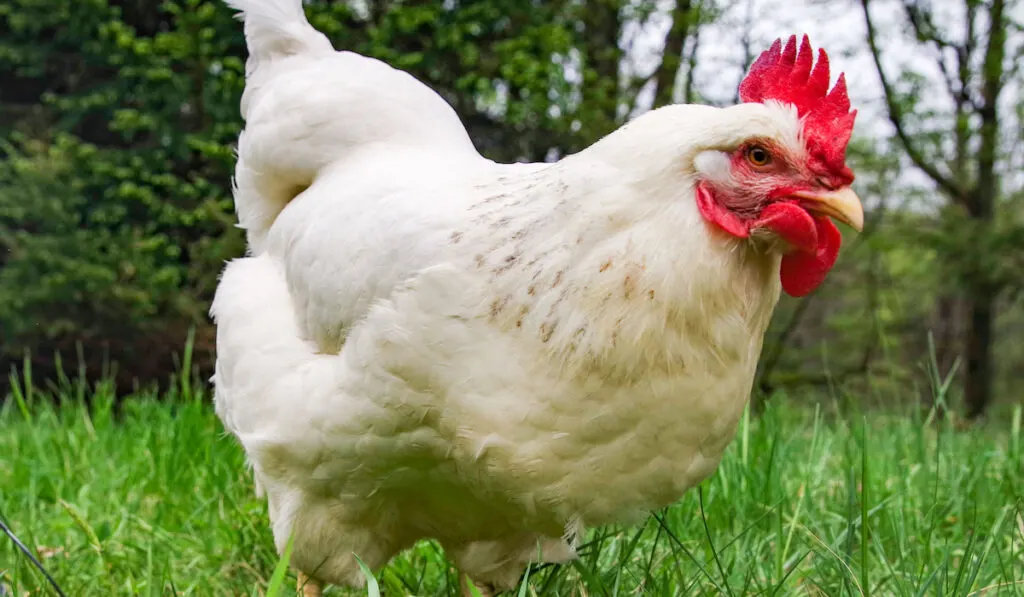
Meat
The yellow color of the Delaware chicken’s skin makes it preferable for eating.
Since the feathers are white, apart from a few specks on the hackle and tail, the meat has no black marks.
A Delaware chicken’s robust body — thick muscles on the thighs and fleshy breast — makes it an excellent source of white meat.
Due to its fast growth and maturity, the breed has tender meat like other broiler breeds.
Ornamental
Some people keep the Delaware breed for ornamental purposes. The thicker the plumage, the more attractive the bird appears.
You can rear these birds to add aesthetic value to your home.
The black specks on their necks and tails make them look striking.
These attractive features make the breed outstanding during exhibitions.
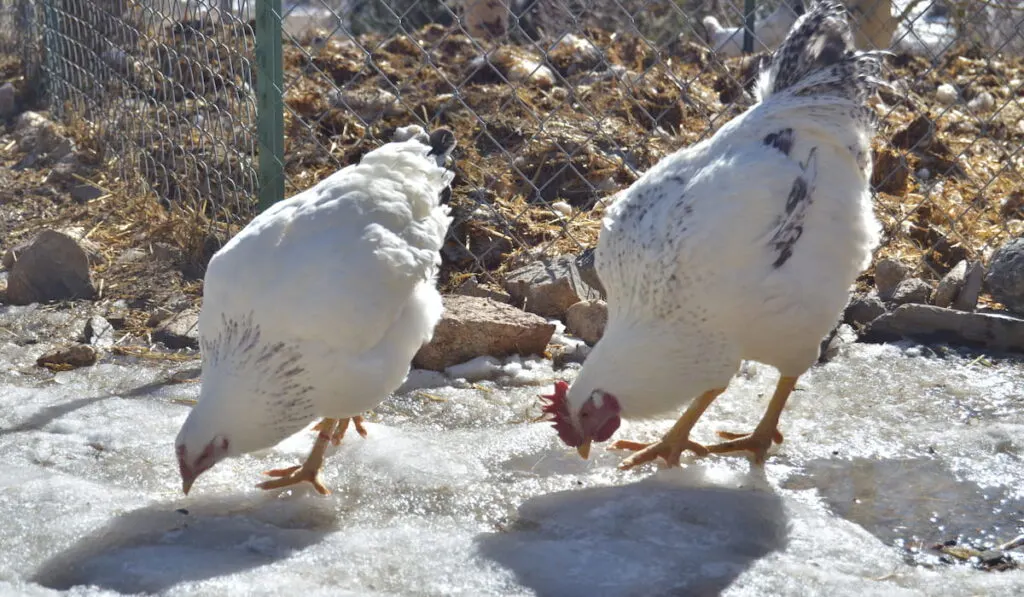
Behavior and Temperament
This chicken breed is active and alert. Maybe these traits arise from their origins: where they were left to loiter on the homestead.
The Delaware chicken excels at staying alert and guarding its young ones against predators. Their attentive and proactive nature may give you the illusion of a hostile breed.
Contrary to many people’s first impression, a Delaware chicken is friendly and calm, especially when it feels safe.
Delaware chicken’s docile and friendly temperament also makes them easy to handle.
When you mix Delaware chicken with other breeds, they tend to be independent. However, they are gentle and always avoid conflicts.
Another unique trait of the Delaware chicken,n when mixed with other breed,s is the tendency to roost last. Many farmers associate this trait with the birds’ protective nature.
They also like foraging, which may also make them roost last.
Lifespan
If you feed the Delaware chicken well and ensure they stay in a predator-free environment, their lifespan exceeds five years.
However, the breed may succumb to unfavorable conditions, such as
- Extreme temperatures (low and high)
- Diseases
- Lack of enough food
- Mites, worms, and lice
- Predator attacks
You can manage the above conditions and help your flock to stay healthy.
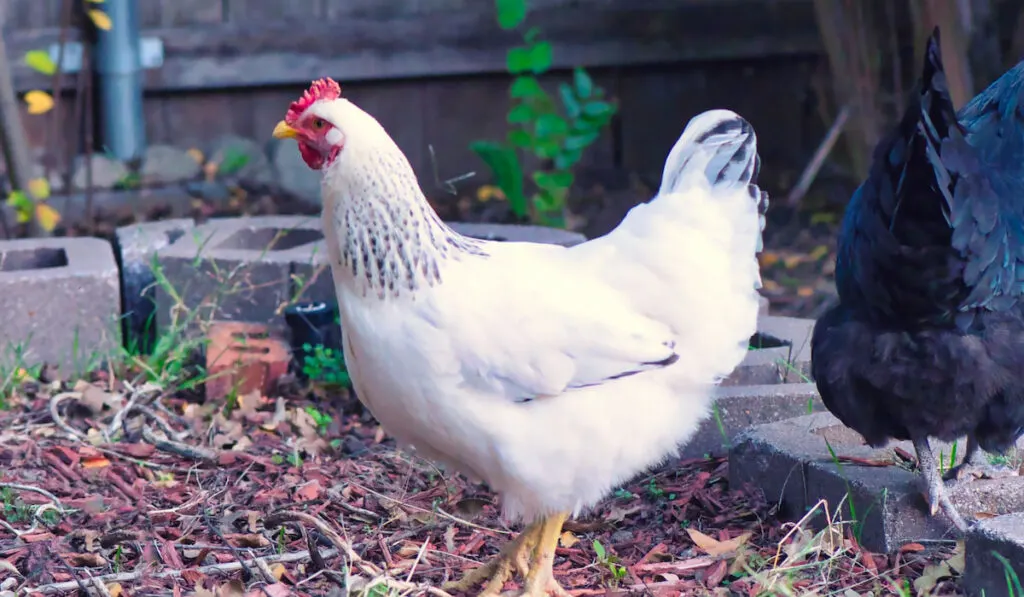
Hatching and Raising Delaware Chickens
Hatching
The Delaware chicken is active and alert. When the time for brooding comes, the hen spends most of its day sitting on the eggs.
The incubation period for the eggs to hatch naturally is 21–22 days.
After hatching, the mother guards its chicks and feeds them until they mature.
If the hen is not there or you want to hatch many eggs, an incubator comes in handy.
When you use an incubator, ensure you maintain proper hygiene and set the right temperature for maximum hatching.
Raising
Rearing chicks after hatching is the demanding part of Delaware chicken husbandry. If done wrong, you may lose all your chicks to diseases and starvation or end up with an unhealthy flock.
The following routine practices are crucial when raising the Delaware chicken.
Feeding
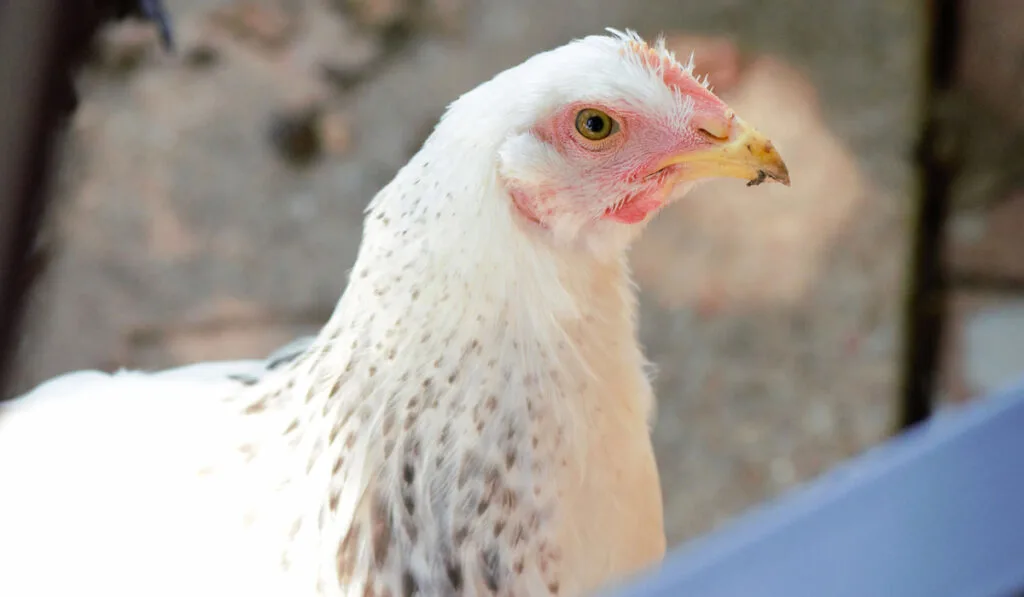
Protein crumble starter feed is ideal for Delaware chicks for the first two months after hatching.
Start with a 24% concentration for the first six weeks to enhance development and growth.
In addition to protein, the chicks need clean water for drinking throughout the day. Avail a controlled amount and replace when contaminated.
If you want to boost their growth, add vitamin powder to the drinking water for the first few days (up to one week).
You can reduce the protein content to 20% and give the growing chicks oyster shells for strong shell formation.
After 16 weeks, your chicks are almost ready to lay eggs. Therefore, you should allow them to forage twice a week.
Foraging improves their alertness and allows them to access more nutrients for body building.
However, you should supervise them and protect them from predatory attacks.
Housing
Delaware chickens have medium to large bodies. Therefore, you should give each at least eight square feet when building their coops.
They also require a perching area, about 20 inches long for each bird.
When the hens start laying eggs, construct some 12-inch-square boxes that are not too deep. This will keep them comfortable since they are not great at flying.
Delawares love foraging but keep them in an enclosed garden for easy monitoring.
A fence about five feet high confines them well since they can’t fly high.
Health
Keeping your Delaware chicken healthy is crucial for maximum productivity and ensuring they grow to maturity.
The breed is known to be hardy and rarely has health problems. However, they are prone to mites, worms, and lice attacks.
To curb parasite infestation, inspect your chickens regularly and maintain hygiene in their coops and foraging area.
Parasites like hiding under the neck feathers and the vent area. If you spot them, repeatedly apply pesticides on your flock and their coops until the parasites disappear.
You can check if your chickens have worms by analyzing their waste or have a veterinarian conduct a fecal-fat test.
A Delaware also suffers viral infections occasionally, such as avian influenza and infectious bursal disease (IBD). IBD is mostly common in chicks.
The following practices are helpful in keeping your Delaware chicken healthy.
| Routine Practice | Reason |
| Keep chicken food and water clean | To prevent diarrhea |
| Give the chicken a controlled amount of water | Too much water lowers their appetite |
| Add electrolytes and vitamins to water | Boosts growth, especially in chicks |
| Add shell grit to older chicks’ food | Enhance strong shell formation before they start laying eggs |
| Avoid overfeeding | Causes discomfort and diarrhea |
Where to Buy Delaware Chickens
You can buy Delaware chickens from small-scale farms and hatcheries near you. If you are in an urban area and don’t know where to buy them, check online.
Many e-commerce stores and hatcheries offer delivery services once you purchase. Depending on distance, a shipping fee may apply.
Before making online purchases, ensure you check the website for other customers’ reviews to avoid losing your money on a bad deal.
The cost of a Delaware chicken depends on sex, age, and size.
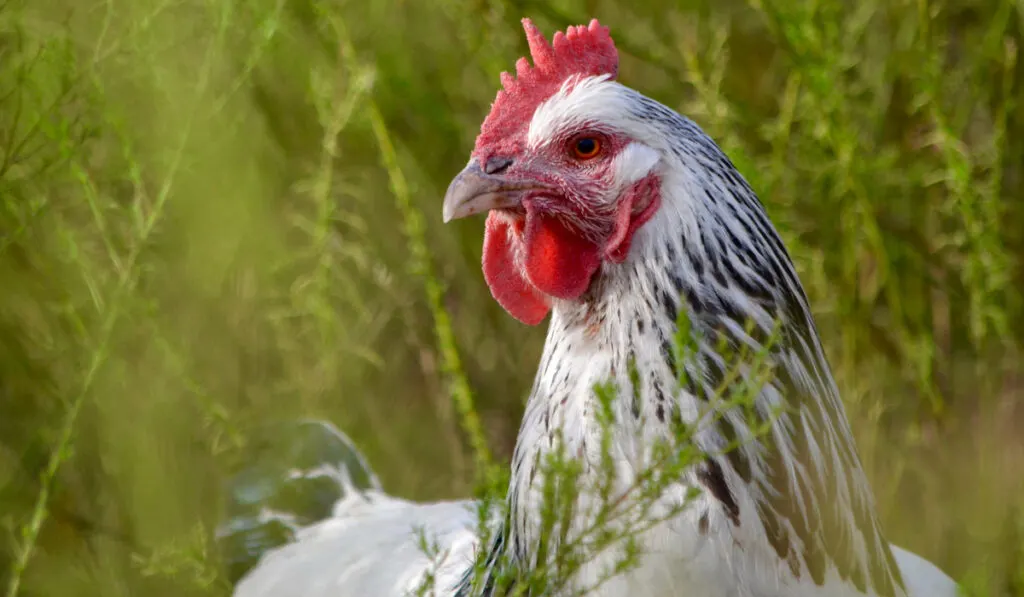
Conclusion
Delaware chickens are ideal for domestic and commercial production.
Whether you want a small flock for your egg and white meat needs or a big flock for commercial purposes, this breed has many desirable features.
Furthermore, their feeding and housing requirements are manageable for beginners.
Resources
- https://backyardpoultry.iamcountryside.com/chickens-101/delaware-chicken-breed/
- https://www.chickensandmore.com/delaware-chicken/#Delaware_Breed_History
- https://www.deerrunfarmmd.com/products/delaware-8-12-weeks?variant=29162207903824
- https://livestockconservancy.org/heritage-breeds/heritage-breeds-list/delaware-chicken/
- https://thriftyhomesteader.com/delaware-chicken/#Meat_Production
- https://www.chickensandmore.com/delaware-chicken/#Feeding
- https://www.chickensandmore.com/delaware-chicken/#Coop_Setup_and_Run
- https://news.delaware.gov/2022/02/23/avian-influenza-found-in-delaware-chicken-flock-producers-urged-to-take-precautions/
